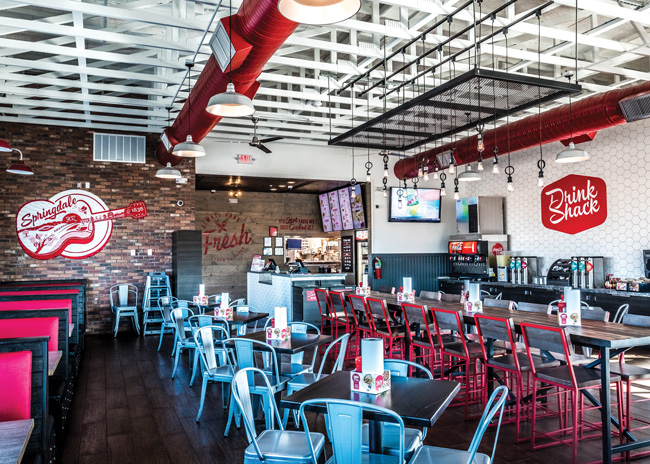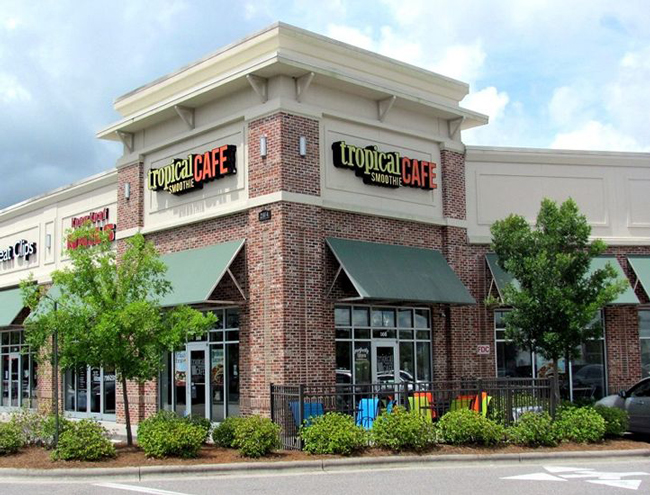A brand that grows to 1,000 units is in rare air. Few restaurant chains grow from humble beginnings to that level. Locations in the quadruple digits means that the brand is — or is likely on the way to becoming — a household name. Certainly, no one needs an explanation of what to expect when a friend says, “Let’s go to Starbucks” (or “Chipotle” or “Panera”).
 Jersey Mikes continually monitors operations at stores including how makeline staff apply oil and vinegar “juice” to subs to ensure consistency. Image courtesy of Jersey Mike’s.On the road to 1,000, when a brand hits the 100-300-site range, it faces several key challenges. At that point — despite already achieving an enviable level of success — brands commonly reassess key aspects of the business. Some look to improve critical items like the composition of the leadership team, real estate development, franchisee recruiting and selection, training, technology and marketing. With rapid growth, the complexities surrounding these issues “grow by an order of magnitude,” says Aaron Allen, founder of the consulting firm Aaron Allen & Associates, based in Orlando, Fla.
Jersey Mikes continually monitors operations at stores including how makeline staff apply oil and vinegar “juice” to subs to ensure consistency. Image courtesy of Jersey Mike’s.On the road to 1,000, when a brand hits the 100-300-site range, it faces several key challenges. At that point — despite already achieving an enviable level of success — brands commonly reassess key aspects of the business. Some look to improve critical items like the composition of the leadership team, real estate development, franchisee recruiting and selection, training, technology and marketing. With rapid growth, the complexities surrounding these issues “grow by an order of magnitude,” says Aaron Allen, founder of the consulting firm Aaron Allen & Associates, based in Orlando, Fla.
First, brands must ensure that they have the right corporate leadership team in place, starting with the CEO. Brands helmed by the original founders for many years may be reluctant to hire an outsider to take the company to the next level. This can be a serious mistake, Allen says. CEOs with years of success growing a single brand may become overconfident and discount contrary points of view on critical issues. This can lead to failure. “Hubris is one of the things that kills brands,” Allen says. “Know-it-alls get clobbered.” He often advises brands to hire a seasoned industry veteran when they reach the low to mid 100s in locations.
Experience matters in other key leadership roles as well. Potbelly Sandwich Shops, now at over 430 locations, is opening about 30 new sites a year. When it embarked on an ambitious growth strategy a few years ago, the company hired corporate leaders with experience from large QSR brands, including Wendy’s, Dunkin’ and Burger King, notes Lynette McKee, senior vice president of franchising. “We fully understand what it takes to operate a brand with several hundred locations,” she says.
Finding the right individuals to staff critical corporate roles is essential. Leaders must be of a common mindset and embrace the company culture. “I can’t tell you how many companies are seeking to exit people that they shouldn’t have hired in the first place,” McKee says.
For most U.S. brands reaching 100 sites, aspiring to 1,000 units means expanding to a much wider geographic area. “A brand with 100 units can be a regional brand,” Allen says. To reach 1,000 stores, most brands must have a nationwide presence, and many develop international locations.
Brands venturing into new geographic markets must consider that cost structures vary significantly in different areas, both domestic and international. The business case in high-cost areas such as large California cities is different than in, say, rural Oklahoma. The break-even point is higher in the former, and this influences location selection. “We know what numbers the store needs to make based on their rent,” says Hoyt Jones, president, Jersey Mike’s Franchise Systems, Inc. A location in a low-cost area could meet its financial goals at a lower volume than a counterpart in a higher-cost region.
International expansion represents high potential for many U.S. brands. “We’re only 5% of the world’s population,” Allen notes. Challenges in moving abroad can be formidable, though. In Saudi Arabia, for example, few people have experience working in restaurants, compared with a high percentage of the U.S. population. Staff therefore require more training in a location like Saudia Arabia. Expanding to a region with a different climate can also pose problems for some U.S. chains. Failing to modify store designs to account for extreme heat or desert dust, for example, can lead to HVAC malfunctions, Allen says.
Our neighbor to the north offers an international expansion opportunity with low risk. Jersey Mike’s, for instance, recently launched an ambitious Canadian expansion strategy as its first major international foray. “Canada is English-speaking,” Jones notes, so it lacks language barriers that complicate many aspects of operations. Even in French-speaking Quebec, English is widely understood. Proximity to the U.S. is a big plus, too. “Many Canadians come to the U.S. for vacations,” Jones says. “Many have already experienced the brand. They are more familiar with us than someone in Korea or Japan would be.”
Growing internationally via franchising comes with a complication that is largely unknown in the domestic market. Some overseas master franchisees — those with dozens of franchised business locations — look to acquire brand rights in their area to block competitors from obtaining them. “Many times, they collect brands like a stamp collector,” Allen says. These operators may have no intention of opening sites for the brand, only wanting to restrict competition for the brands that they currently own. Thus, choosing overseas franchisees takes great care. “A lot more due diligence is required,” Allen adds.
Indeed, finding the right franchisees is near the top of any QSR brand’s to-do list. Some brands welcome franchisees that are new to franchising or that own just one or two sites, but others only consider more experienced operators. “Number one, you have to have owned and operated multiple restaurants,” says Jackie Lobdell, vice president of franchise development, Slim Chickens. The fast-growing brand prizes franchisees that have shown they can manage more than a couple of locations for other brands.
To vet franchisees, Slim Chickens tours prospective franchisees’ existing stores, examining details including the cleanliness of the restaurant, how well they take care of equipment, landscaping appearance, back-of-the-house efficiency and how they treat employees, Lobdell says. These tend to be indicators of a successful operation. “If a brand goes out of business, 80% to 90% of the time, it is because operations are lacking,” she adds.
Finding potential franchisees that match rigorous criteria isn’t easy, says Jim Cannon, chief development officer at Bojangles’ Restaurants, Inc. “The greatest challenge is finding franchisees where you want to grow,” he says. “Especially after COVID, some of our franchisees are a little scared to go into a new market.” In some new markets, Bojangles has opted to open corporate-owned stores as flagship locations. Once a corporate store has success in a new metro area, franchisees gain confidence to open their own location in the region. “[A corporate site] also demonstrates our commitment to the brand,” he adds. “We feel the supply challenges and the cost challenges along with franchisees.” Of Bojangles’ 823 sites now in operation, 267 are company-owned.
When Bojangles readies a franchise opening, it assigns a concierge to the owner. This veteran company representative helps the franchisee analyze the local labor market, hire suitable staff, set up operations, train staff and market the store. “A concierge has grown through the operational ranks as part of expansion teams,” Cannon says. This role is crucial to getting new sites off to a good start.
Training is an ongoing process for many firms, including Jersey Mike’s. “We are constantly in stores providing feedback,” Jones says. “Each store gets a visit at least every four to six weeks, sometimes more often.” The brand aims to maintain consistency of quality in its offerings and service — a trait that it believes is key to ensuring that new sites succeed. “We are constantly reinforcing positives and making corrections,” he says. For example, company representatives focus on details such as making sure that sandwich makers use the right technique for sprinkling oil and vinegar “juice” to get the right proportion of the liquid on subs. Such attention to detail is important for brands to stay on their desired growth track, he says.
 To vet franchisees, Slim Chickens tours prospective franchisees’ existing stores. Image courtesy of Slim Chickens.
To vet franchisees, Slim Chickens tours prospective franchisees’ existing stores. Image courtesy of Slim Chickens.
Some brands that grow to beyond the mid-hundreds in sites, such as Bojangles and Jersey Mike’s, have enough revenue to build their own IT teams. “We are very fortunate to be of the size to be able to have our own phenomenal IT team,” Cannon says. “A 300- to 400-site chain may not be able to support their own IT team.”
“When I started here, we had embarked on developing our own internal POS system,” Jones says. “Now, we have 80 to 90 IT people.” The dedicated internal IT staff offers competitive advantage as it allows the firm to optimize systems for customers, he says. “Our app is rated 4.99 [stars],” he says. “About 40% of our business is through digital now.” With IT staff embedded in the corporate structure, app developers learn how to best appeal to the brand’s customers and how to closely integrate marketing initiatives with customer-facing applications. Brands that outsource development of critical IT functions, such as ordering apps, may not be able to adjust app functionality to new strategies and marketing campaigns as well and as quickly as those that have in-house software development.
Reaching a certain size gives brands the wherewithal for national marketing campaigns as well. When Jersey Mike’s approached 500 units, it launched its first national ad buys. “We couldn’t do that until we got into all the major markets — New York, Chicago, and LA,” Jones says. As the brand continues to grow, targeting 3,000 sites by the end of 2024, it can engage in more large-scale marketing opportunities, such as the sponsorship deals it has struck with the National Hockey League and the National Collegiate Athletic Association. These types of brand-boosting initiatives are possible when a chain has a national presence and generates revenue from hundreds of locations.
Undeniably, growing well beyond the 100-unit level poses tough challenges, but brands that reach the high hundreds and beyond gain quite a bit. There is nothing like household-name awareness to foster further growth and long-term success.



